Express Entry Quarterly Review: Number of ITAs Issued Skyrockets
The opening months of 2017 have been a groundbreaking period in the history of Canada’s Express Entry immigration selection system. More candidates are being invited to apply than ever before, processing times remain short, and successful applicants continue to land in Canada as permanent residents. This quarterly review will take stock of the year so far, while also looking forward to what may come in the future.
Through the opening three months of 2017, a total of 24,652 Invitations to Apply (ITAs) for permanent residence have been issued by Immigration, Refugees and Citizenship Canada (IRCC), an increase of more than 160 percent on the 9,465 ITAs issued over the first quarter of 2016. For the same period in 2015, a total of 6,851 ITAs were issued.
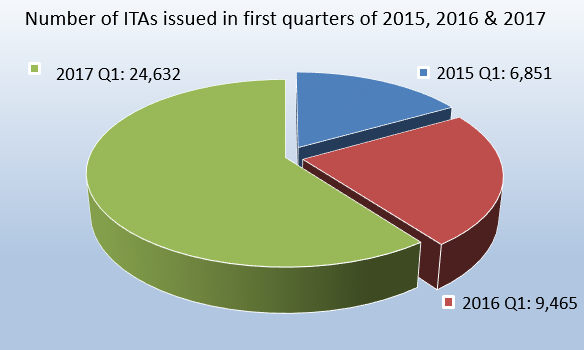
Indeed, the number of ITAs issued to candidates in the pool over the first quarter of 2017 is far greater than during any other quarter since the Express Entry system was first launched in January, 2015.
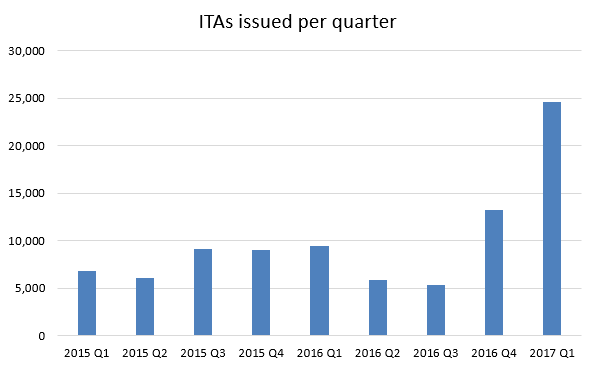
The increase in the number of ITAs issued was not entirely unexpected, as IRCC had stated last year that it expected invitation rounds (draws) to increase in size through the fall/autumn season. However, the scale of this increase was substantial, and the effect of this increase on CRS cut-off thresholds is clear to see when compared with the opening months of 2015 and 2016.
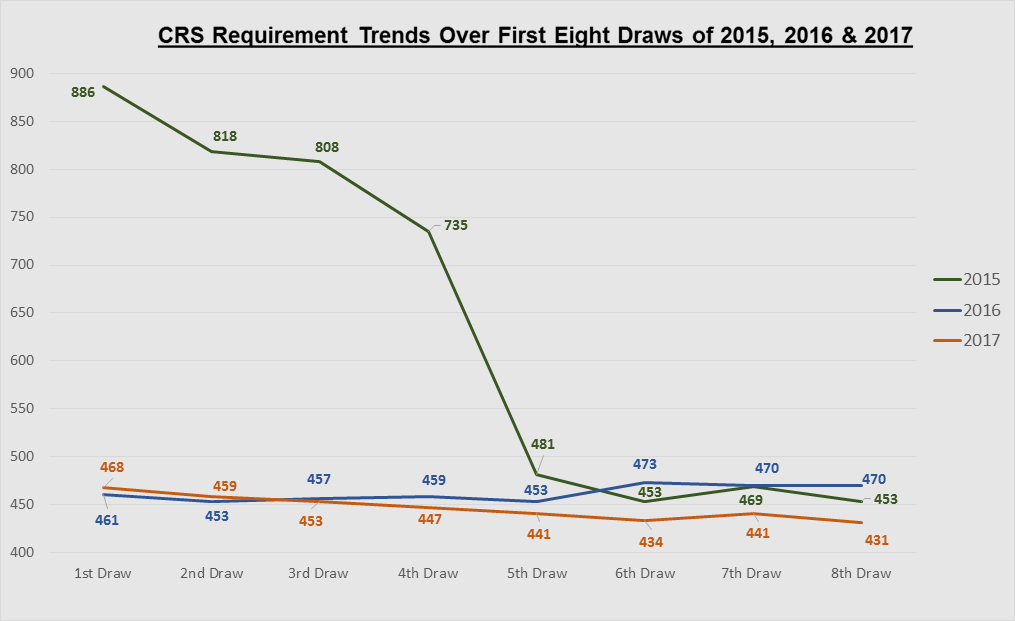
Other factors contributing towards this increase include a reduction in the backlog of applications submitted under the federal economic immigration programs before Express Entry was launched, as well as Canada’s Immigration Plan for 2017, which targets more newcomers through these programs — now managed through Express Entry — than ever before.
A transitional period
Early 2017 may be seen as a transitional period within the unfolding history of Express Entry, coming as it did between two sets of improvements to the system.
The first set of improvements came last November, when the number of Comprehensive Ranking System (CRS) points awarded for a qualifying job offer was changed from 600 points to either 50 or 200, depending on the position offered (note: a job offer is not required to immigrate to Canada through Express Entry). In making these changes, IRCC predicted that ‘a reduction of points to candidates with arranged employment means the CRS cut-off will decline,’ adding that it aimed to ‘balance the Comprehensive Ranking System to put greater weight on human capital, skills and experience.’
While the number of points a candidate could obtain for a job offer decreased, the requirements surrounding such a job offer were relaxed to include many candidates holding employer-specific work permits in Canada. Therefore, a number of candidates in the pool were immediately in line for a 50- or 200-point boost to their scores.
As a result, it was expected that the CRS threshold in the first few draws after the changes were introduced would actually go up temporarily to allow for the fact that more candidates with job offers could claim additional points. Once this initial group of candidates exited the pool, however, IRCC expected the CRS threshold to go down.
Ultimately, this is what happened through closing weeks of 2016 and into 2017, as the point requirement for a candidate to receive an ITA went from 497 to 434 in just two-and-a-half months. In that time, the CRS threshold reached a new record low on three occasions. In addition, by inviting more candidates IRCC had to reach deeper into the pool — therefore, more candidates were in line to receive an ITA.
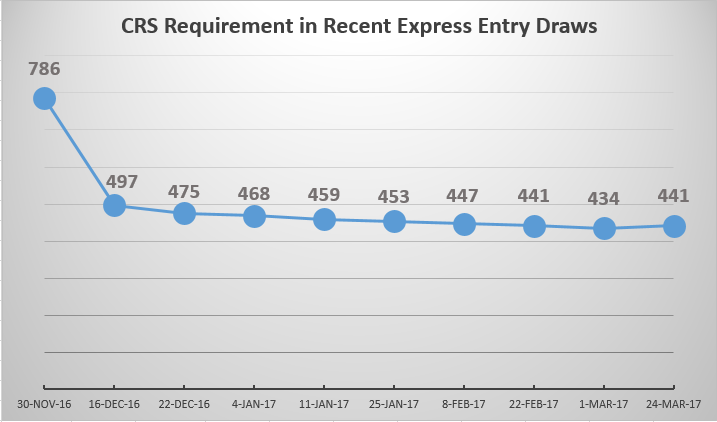
Candidates who had studied in Canada also benefited from the introduction of additional points for their Canadian education last November.
The next set of improvements to Express Entry are due come into force on June 6. The three changes to come are the introduction of additional points for candidates with a sibling in Canada, additional points for candidates with French ability, and a change to make registration in the Canada Job Bank voluntary. These changes are not expected to alter the CRS as significantly as the changes introduced last November.
The effect of Provincial Nominee Programs
Since IRCC made improvements to the CRS last November, provincial nomination has become by far the most valuable factor — the only factor worth 600 points, in a system that awards up to 1,200 points in total.
The number of newcomers expected to arrive through a Provincial Nominee Program (PNP) in 2017 is around seven percent higher than last year’s target, and most PNPs include at least one enhanced stream aligned with the Express Entry system. Indeed, Ontario, BC, and Nova Scotia have each opened multiple enhanced streams since 2015, while other Atlantic provinces and Saskatchewan have also engaged with Express Entry on an ongoing basis through their PNPs.
Around 13 percent of candidates issued an ITA in 2015 had obtained a provincial nomination. However, over the first nine months (or 20 draws) of 2016, this figure increased to 23 percent, showing the increasing importance of these programs over time as more provinces welcome newcomers through their enhanced streams.
The 600 CRS points that may be obtained through provincial nomination has an effect on the make-up of the pool as a whole, as certain proactive candidates benefit from a nomination. This can contribute to an increase in the CRS threshold in some draws from the pool; for example, in the most recent draw the threshold moved from 434 to 441 following a slightly longer gap than usual between draws. A longer gap may have given more candidates an opportunity to obtain a nomination in the meantime, and the threshold may then have increased as a result.
Admissions to Canada through Express Entry
On March 31, IRCC disclosed that Canada has welcomed more than 43,000 new permanent residents through Express Entry since its launch in January, 2015.
Given that the department had already released a half-year and a full-year report on Express Entry for 2015, including data on admissions, it can now be revealed how many more admissions took place over the last five quarters compared to the first year of the system being operational.
Over the first six months or so of 2015, 411 new permanent residents landed in Canada through Express Entry, an average of 16 per week. This relatively low number can be attributed to the fact that these newcomers would have had to receive an ITA, submit an e-application, successfully have that application processed to completion, and physically land in Canada — all within six months. Indeed, the fact that Express Entry admissions were possible within this period shows how successful IRCC was in making the process quick and simple.
Over the next six months, the rate of admissions shot up to an average of 361 per week. And since early January, 2016, this rate has again increased to 514 new landings per week.
Suffice to say, Canadian immigration authorities are welcoming more and more new immigrants through Express Entry as time goes by. Besides, the increased number of ITAs being issued over recent months will mean a corresponding increase in the rate of admissions, as IRCC sees the Express Entry system as the main driver of economic immigration to Canada.
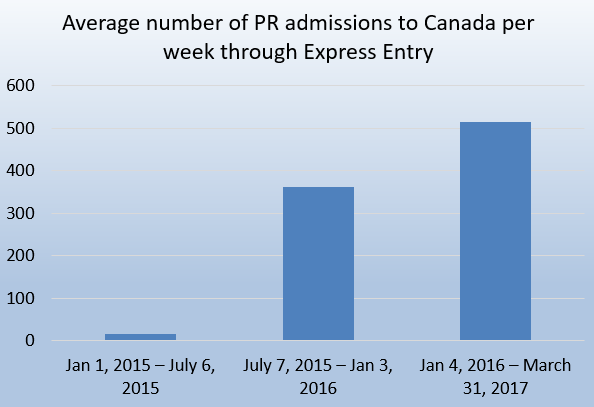
A look forward
“Overall, the first three months of 2017 can be viewed rather positively on reflection. The improvements made last November have had the desired effect of more candidates being invited based on the human capital, skills, and experience. These improvements, past and future, show that the Liberal government is optimizing its economic immigration for the betterment of the country and its economy,” says Attorney David Cohen. “And if draw sizes remain relatively large — or increase again — we may see lower CRS thresholds deeper into 2017.
“There are many steps that individuals may take towards realizing their Canadian immigration goals through Express Entry, depending on where they are in the process. Getting into the pool with an accurate, up-to-date profile is the first, and after this point it’s about being proactive, keeping track of PNP updates and developments, and finding other potential ways to improve your chances of selection.
“Once an ITA has been obtained, it is then crucial to have documents and forms prepared and reviewed so that you can join the more than 43,000 individuals who have already made Canada their home through Express Entry.”
A New CRS Calculator is Available
Readers can use the new and improved CRS Calculator to find out what their score would be under the existing system, as well as under the tweaked system due to come into force as of June 6.
To find out if you are eligible to immigrate to Canada permanently, fill out a free online assessment form.
© 2017 CICNews All Rights Reserved
- Do you need Canadian immigration assistance? Contact the Contact Cohen Immigration Law firm by completing our form
- Send us your feedback or your non-legal assistance questions by emailing us at media@canadavisa.com




